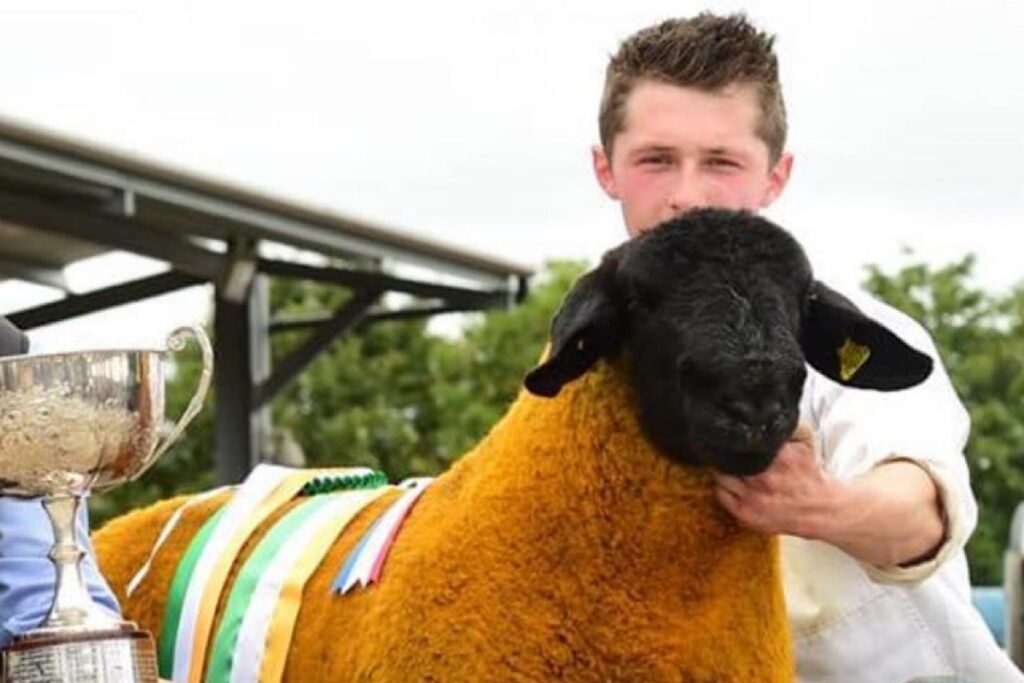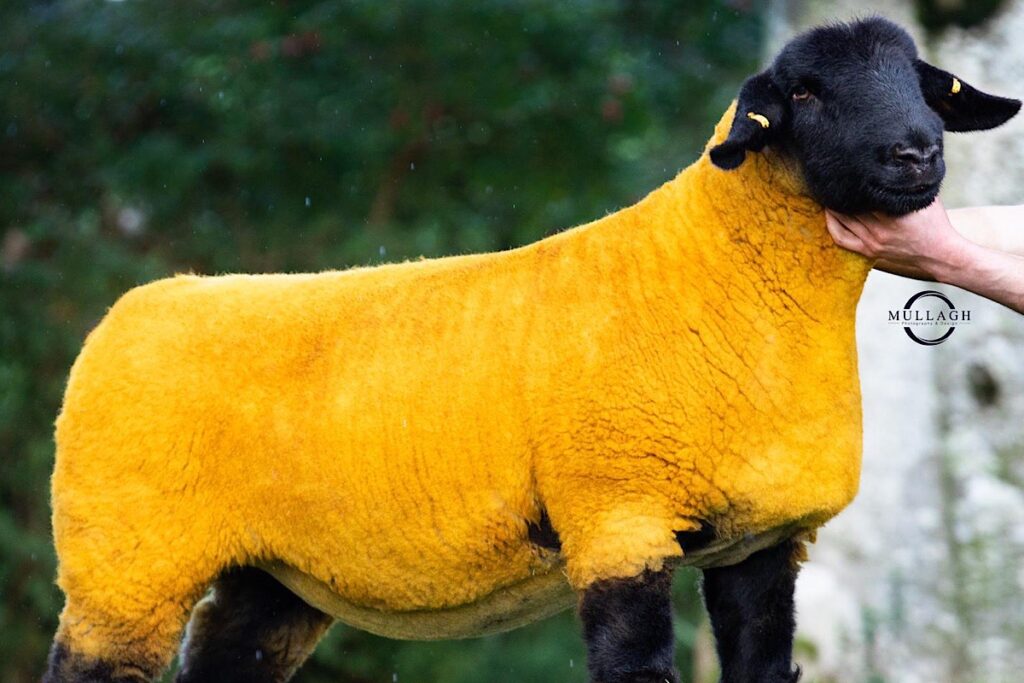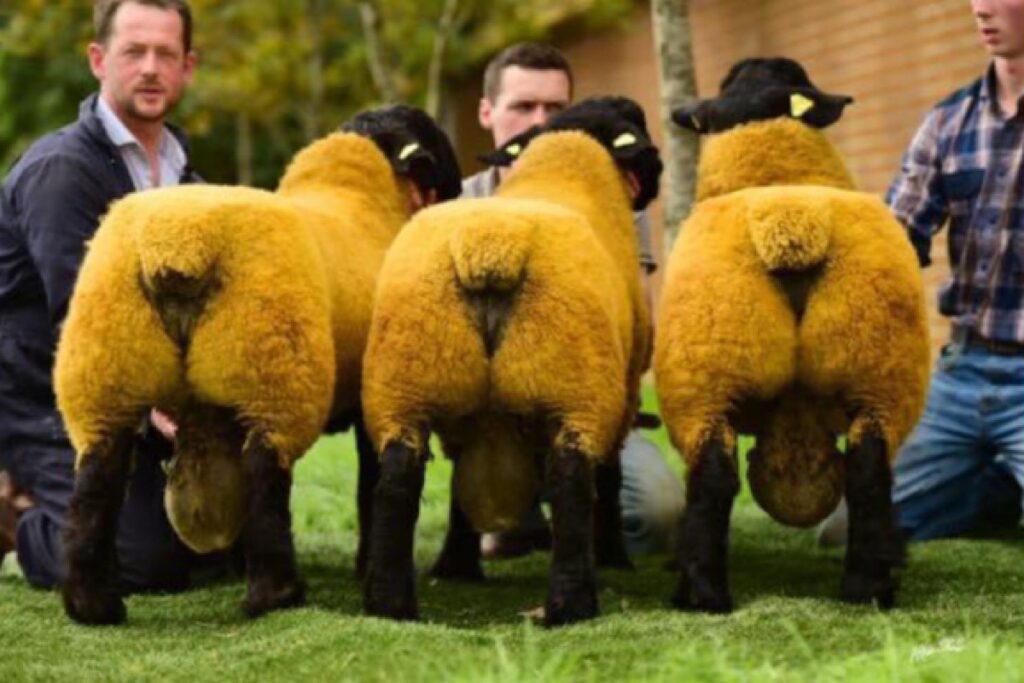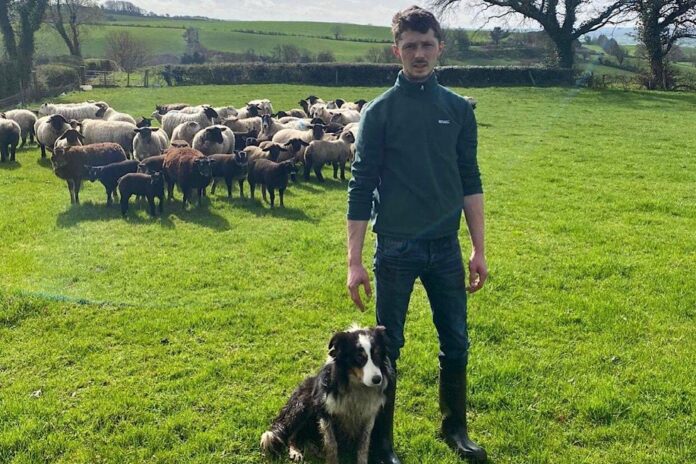In this week’s sheep farmer segment, That’s Farming speaks to Andrew Lucas, Donegal. He discusses running Finnvale Suffolks, entering an official farm partnership with his father, breeding sheep to €3,000, sheep sales overseas and branching into Badger Face Texels.
In five years, the Lucas family from Killygordon, County Donegal, plan to be on top with other top pedigree sheep breeders on an Irish and UK level, win the champion at the All-Ireland premier sale in Blessington and secure the highest price.
The family attend sheep sales throughout Europe and have bred ewes to €3,000, the highest they have ever achieved, which was at the Black Beauty Sale in December 2021.
In 1990, they established their Finnvale pedigree Suffolk flock from females they purchased in Northern Ireland at in-lamb sales and rams in Scotland and overseas.
The farm consists of 50 pedigree Suffolk ewes, some pedigree Badger Face Texel sheep, 150 Suffolk Mule-cross and Suffolk-Cheviot-cross ewes (for ET work) and a 100-cow British Friesian-cross-Holstein Friesian dairy herd.
Andrew and his father, Johnathan, who entered an official farm partnership in 2017, operate the enterprise. It consists of a 150-acre home block of land for dairy cows and a 200-acre out-farm (leased land) for calves and sheep.
“I am the sixth generation to milk cows. Growing up, I was out and about on the farm and into everything. Since I could reach the milking clusters, I was milking cows,” Andrew Lucas, a Level 6 Advanced Certificate in Agriculture (Dairy Herd Management) graduate at Gurteen Agricultural College, told That’s Farming.
“There were always cows and always sheep. Before we started pedigree sheep, my grandfather, Leonard, had 400-500 ewes,” the Blue Texel Sheep Society member added.
Andrew’s grandfather previously farmed 60 dairy cows on the holding.
Donegal sheep farmer
When Andrew finished college, the family decided to reduce sheep numbers and focus on dairying and expanded to 100 cows – due to the family’s other commitments, including the father and son’s mart-related commitments.
Andrew’s father is an auctioneer in Ballybofey and Stranorlar Co-op Livestock Mart Limited and Milford Co-Operative Mart Limited.
In addition, Andrew works three nights a week as a drover at Ballybofey and Stranorlar Co-op Livestock Mart’s sheep and cattle sales.
Breed choices
The farm aims to breed the “best” sheep by buying the best rams available, buying ewes from other flocks, purchasing semen, and undertaking ET work.
“In my opinion, the Suffolk sheep breed is a great sire for killing lambs. Suffolk is always the first out the door; you cannot beat their growth rates.”
“I like Suffolk sheep to have good colours, good carcass, good skin and good power and size.”
The family established their pedigree Badger Face Texel flock from two ewe purchases in Carlisle from Jewitt and Sunnybank Pedigree Livestock, Henry Jewitt, one from the Woodies flock in Scotland and two Belgium imports.
Andrew’s brother Sam inspired him to diversify into the breed.
“We were thinking about starting another breed, and we did not know what to go for. I suppose we thought Badger Face Texel sheep were something different. There are not a lot of them in the Republic of Ireland. So, that is what made my father sway to the breed.”
Breeding programme
The Lucas family use two Suffolk stock rams, Salopian Pure Gold from the UK, and Fronvoy Formula 1 from Wales.
The family AI all their pedigree ewes and put rams out for repeats and commercial sheep, not in use for ET work or did not hold embryos.
In the past, the family flushed 10-12 Suffolk ewes with a yield of 8-15 embryos.
In contrast, they also completed ET work with The Sheep Vet, Patrick Grant, on five Badger Face Texels with an average of 8-15 embryos and 60% conception rates.
“ET work for the Badger Faced Texels will start of September. The five Badger Face Texel ewes are flushed and then put out naturally to the ram again.”
Lambing
The Donegal-based family lamb their pedigree Suffolk sheep from the end of December, the Badger Faced Texels from the beginning of February and commercials from March 17th.
The Lucas family lamb their pedigree sheep during this period to enable lambs to “develop size and power” before sales. Their reason for the commercials lambing is to allocate them breaks and for grass growth post-lambing.
The family monitor their lambing season by checking ewes regularly in a dry-bedded shed beside their house.
The shed has 5×5 pens and sheep hurdles, with lambs transferred into bigger pens as they thrive.
“We try to have lambing as tight as possible and have each section as tight as possible to save yourself getting too tired. So, we like to keep it as compact together as possible.”

Progeny
The family has a strict culling policy and sells their non-performing pedigree Suffolk lambs at the mart each Easter. They sold seven, weighing 48kgs, on average for €172/head this year.
“Our policy is if it is not good enough, it does not stay. In my view, there is no point keeping a middle-of-the-road sheep; you have to keep the best to be the best.”
The family retain all their females until hoggets.
“We sell about 20 female hoggets every year at a few summer sales. The hoggets would be sold dry at an online sale in Carlisle through Harrison and Hetherington and Black Beauty sale in Blessington.”
The family sold three Suffolk hoggets for €1,450, €1,200, and €1,050, respectively, at the Harrison and Hetherington sale; two went to Portugal, and a French buyer secured the other.
“Last year, we had a very good year at the Blessington in-lamb sale as we topped it at €3,000 for an in-lamb ewe.”
“I feel it all about luck and who is interested in your sheep on the day. Your sheep could make from €800-€5,000,” the Donegal sheep farmer added.
Sales
They send their pedigree ram lambs to the South of Ireland Premier Show and Sale in Blessington Mart on July 25th and commercial Suffolk ram lambs to Raphoe Livestock Mart with prices ranging from €500-€900+.
“This is our first year having the Badger Face Texel sheep, and there are a few different sales that we are planning on going to.
“There is a summer sale in Ballybofey and Stranorlar Co-op Livestock Mart Limited. A few lambs will be going to that sale, and then there is another sale in Carrick-on-Shannon, which is the Irish Blue Texel Sheep Society sale.”
“Also, there is another sale in December in Ballybofey and Stranorlar Co-op Livestock Mart Limited for Texels, Spotted Dutch and Valais Blacknose sheep.”

Grassland management and challenges
The family manages the farm by grazing sheep on the out farm and dairy cows on the main block of land.
“We run a strip grazing system for the cows, and then sheep are moved from field to field. We put in a forage crop for ram lambs.”
Challenges that impact the family include managing stock and rising input costs.
“Meal and fertiliser costs are hitting me big time; it is not easy. Meal prices have increased a lot since last year. I think the meal we are feeding was around €11-€12/bag, and now it is €14-€15/bag; it all adds up.”
Pedigree breeding
The South of Ireland Branch Suffolk Sheep Society members shared some advice for aspiring pedigree sheep breeders.
“I would tell anyone to start as they mean to go on. So, buy good sheep at the start; it will save a lot of hassle along the way.”
“Also, talk to breeders, go out to shows and get a feel for the breed you are going for.”
“I would say do not go into bigger numbers. Have smaller numbers as it is a lot easier to work and easier to manage and look after your sheep.”
“You have to spend money if you want to make money in pedigree sheep, and you have to be there – stockmanship is paramount. So, you have to more or less live with sheep and that is the truth.”
The family are also regular attendees of the Finnvalley Show, where they showcase their flock.

Plans and the future of Irish sheep farming
The family intends to expand to 120 dairy cows, maintain more “quality rather than quantity” when it comes to pedigree ewes, and concentrate on ET work on their superior ewes.
“You go out, and you have to buy the best rams available every year. You have to try to keep improving every year. So, you try to keep your best few females every year.”
Commenting on his view on Irish sheep farming, Andrew said:
“Sheep farming is possibly a viable business, but pedigree sheep farming is a hobby. It is an expensive hobby, but it is a hobby you can be lucky. There is money to be made. You have to have an interest in sheep and work with them.”
“Also, I have a big interest in milking cows. I think cows are more profitable.”
“If it were just sheep here on the farm, I would have a part-time or even full-time job and sheep on the side. I suppose only for the dairy cows here and me working in the mart, that is handy,” the Donegal Suffolk Club member concluded.
To share your story like this Donegal sheep farmer, email Catherina Cunnane, editor of That’s Farming, – [email protected]
See more sheep farming profiles





